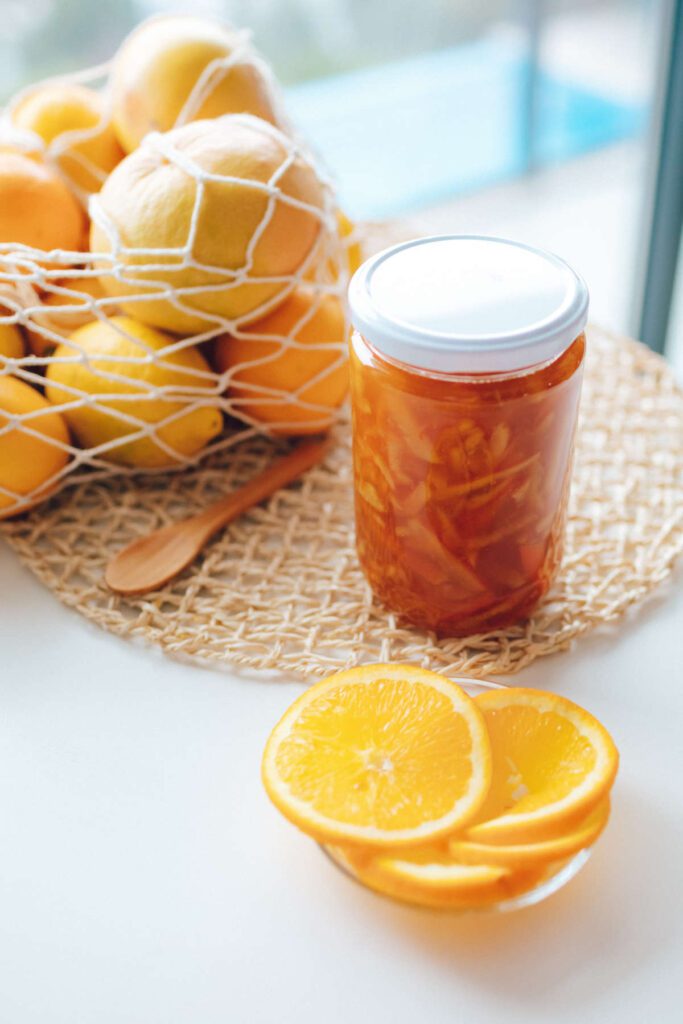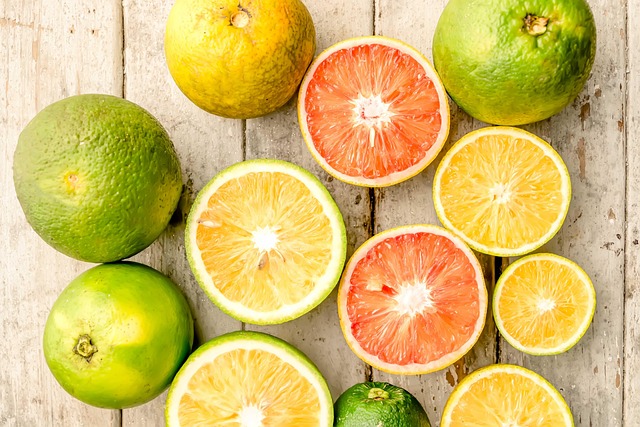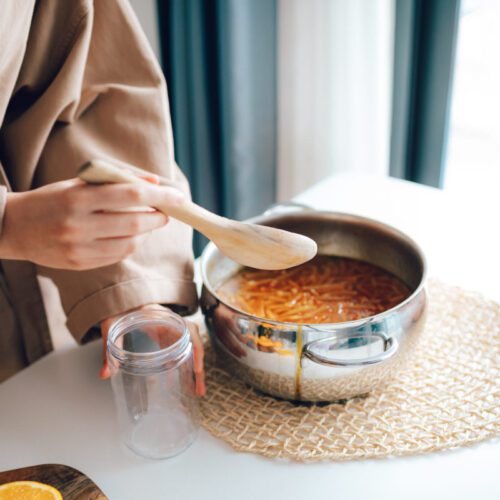Marmalade is a type of jam that is traditionally made from citrus fruit. This is a unique kind of jam. It should be considered separately from other jams in terms of how it is made and how it is enjoyed.

History of Marmalade
Marmalade has a long history dating back to the medieval period. At that time, it was made from quinces, not citrus fruits. And its name comes from the Portugese word for quince. Quince marmalade was often used as a medicine, thought to be effective for treating colds and sore throats. It wasn’t until the 16th century that this jam became a food.

By then, citrus fruits were being used to make it. By the 17th century, oranges had become the most popular fruit for making this preserve. It steadily became well-known and enjoyed in England. Today, marmalade is still made from citrus fruits, though new flavour combinations are still being created.
Early marmalades were very different from the spreadable fruit preserve that we know today. They were more like thick sauces and were often used as an ingredient in other dishes. It was still later that it began to be eaten on its own. By the 19th century that it became the spreadable preserve that we recognise today.
Today, marmalade is most commonly made from oranges, but lemons, limes, and grapefruits are also sometimes used. In addition to homemade marmalades, there are also many brands of commercially made marmalades. These cover the flavour range from orange to lemon and lime versions.
A Distinct Kind of Jam
Unlike other jams, which are typically made from sweet fruits such as strawberries or raspberries, marmalade is made from citrus fruits, like oranges, lemons, limes, and grapefruits. Oranges are the most commonly used.

While most jams are made with just the fruit pulp, marmalade includes the peel, zest, and juice of the citrus fruit. This gives it a strong flavour that takes some getting used to. The peel of the fruit adds the characteristic bitterness, while the citrus juices and zesty skin oils enhance its fragrance.
It has a tart and tangy flavour that is not usually enjoyed by children. Many people only develop a taste for it as they get older. Although there are still many adults who find its unique flavour to be an acquired taste.
The Making of Marmalade
Marmalade is also thought to be notoriously difficult to make, as the bitterness of the fruit can make it hard to achieve the right balance of sweetness and tartness. And while the traditional method of making marmalade involves hours of simmering and stirring, there are now many recipes with shortcuts that can be used to make this preserve less time and effort-consuming.
Over time tips on amending the making process have accumulated and can include flavour enhancements, variation in peel thickness, and options to try if you want to make the outcome less bitter and intense, and more palatable to a wider audience.
Methods have also expanded to include variations in the preparation and cooking of the citrus jam mixture. The use of kitchen utensils and appliances such as vegetable peelers, microwaves, food processors, slow cookers and pressure cookers now all feature in the creation of this tasty jam. This has made it possible for anyone to give this a try depending on the choice of recipe, method, convenience etc
Enjoying Marmalade
Marmalade is a versatile spread that can be used on toast, scones, as a cake filling, stirred into yoghurt or oatmeal, or even through and over ice cream!
It is also a key ingredient in many cocktails, including the classic gin and tonic, and can also be used in cooking, as an ingredient in savoury dishes or sauces.
So if you are looking for something new to try, give marmalade a chance – you might be surprised by how much you like it!
My favourite is grapefruit marmalade. Delicious on toast with some cheese on the side. Sublime!

Easy Orange and Ginger Marmalade Recipe for Beginners
Equipment
- 1-2 small plates (for testing theset of the marmalade)
- Kitchen scales
- Chopping board and a sharp knife Kitchen scissors
- Large saucepan (NOT aluminium or cast iron)
- Long-handled spoon to stir.
- Potato masher Or immersion blender
- Vegetable peeler
- Freshly cleaned, sterilised glass jars with sealable lids.
- Ladle
- Jam Funnel
- Kitchen paper towel or clean damp cloth
Ingredients
- 300 g clementine or satsumas oranges or any ‘easy peeler’ oranges. I have used clementine/ satsumas/any 'easy peeler' variety in this recipe because this makes the task of preparing the peel easier.
- ½ medium lemon
- 200 g white sugar Do NOT alter the sugar amount as this ratio of 200g of sugar to 300g of citrus fruit helps the mixture to be more likely to realise a set texture.
- 225 ml water
Instructions
- You start by putting the small plates into the freezer.
- Wash the oranges and lemon and allow to drain any excess water.
- Weigh and peel the oranges and set the peel on a cutting board. Set the orange flesh aside for now.
- Start cutting the peel into slices – thinner, smaller slices for a lighter texture or wider slices for a thicker more chunky textured marmalade. It is helpful for even cooking to keep the slices similar in size.Then add the orange peel to the saucepan.
- Next, you use the vegetable peeler to peel the skin from the lemon, keeping this as thin as possible. Slice these thin peelings again, as you did with the oranges, and add them to the saucepan.
- Cut the lemon in half and set one of the peeled lemon halves aside with the peeled oranges for now.
- You then add the water to the peels in the saucepan, and gradually start to heat the water-and-peel mixture until it starts to boil. Once it has reached boiling point, you turn the heat down, put the lid on the saucepan and allow themixture to simmer for 20-30 minutes. It is important to check on this every 10 minutes to make sure that enough water remains in the saucepan – this will prevent the ingredients from burning, but the water is essential here as this step is aimed at softening the peel ahead of final cooking. If the water is low, just add some more.
- While the peel is softening on the stovetop, you start to cut up the flesh of the oranges into small to medium chunks (this will cookdown). Remove and discard any pips. Swiftly add the orange pieces to a bowl trying to save as much of the juice as possible.
- Going back to the peeled lemon – cut it in half, removing any pips. Scoop out the lemon flesh, rough chop and add to the chopped orange in the bowl. Cut the remaining white half lemon peel in half and add to the mix– the pectin it will release while cooking will support the setting of themarmalade.
- When the peel and water mix have finished simmering and the peel starts to feel softened, you can carefully add the chopped orange and lemon pieces, followed by the sugar. Stir the mixture well.
- Turn up the heat aiming to bring the mixture up to a boil.While this is happening, stir to ensure that the sugar is completely dissolved.
- Then allow this mixture to boil for 10 minutes, stirring every 5 minutes to avoid scorching and to distribute the heat throughout.
- After 10 minutes of boiling, carefully use the potato masher to break up the citrus flesh and release more juices. This will also create a smoother marmalade. While you can use an immersion blender for this step, use only a couple of pulses to avoid breaking up all your finely sliced peel too!
- Allow the mixture to continue to boil rapidly for a further 5 minutes.
- Start to test the mixture for the set point, using the plate from the freezer. If not set, boil for a further 2 minutes and retest. Repeat as needed.
- Once the set point has been reached, you remove the marmalade from the heat. Remove the 2 white quarter peels of the lemon.
- Let the marmalade stand for 5 minutes.
- Now you can ladle your marmalade into the jar(s) – I always have an extra 1-2 jars prepared, just in case needed. Wipe off the rim of the jars with damp kitchen paper or clean cloth and place the lids on the jars.
- Allow the jars to cool completely at room temperature for at least 24 hours.
- This marmalade can last up to 2 months in the fridge. Youcan also freeze it for up to 12 months.
Nutritional Disclaimer
All nutritional information is an estimate only, based on third-party calculations derived from an online nutritional calculator, Spoonacular API. The data provided is a courtesy and should not be considered a guarantee or fact. Each recipe and nutritional value will vary depending on the ingredients and brands you use, your measuring methods and portion sizes. For accurate results, we recommend that you calculate the nutritional information yourself, using a preferred nutritional calculator or advice from a nutritionist, based on your ingredients and individual processes.